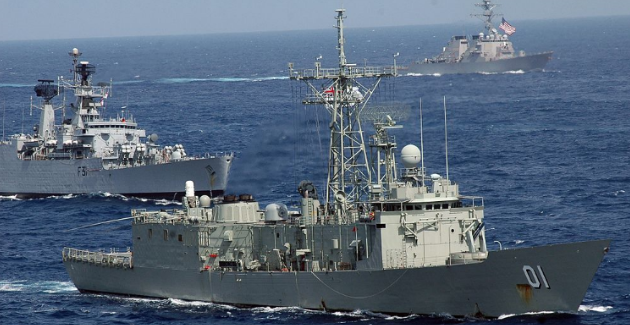Is Exercise Malabar Another Snag in Australia-India Relations?

Reports that the Indian government intends to block Australia’s participation in this year’s Malabar naval exercises are a setback for Canberra. However, better indicators of the health of the Australia-India bilateral relationship may be found elsewhere.
When Malcolm Turnbull returned from India earlier this month, it looked as though the Australia-India partnership was back on track, with renewed investment in bilateral educational diplomacy and a broadening of security ties. True, both sides conceded that they were unlikely to conclude the Comprehensive Economic Cooperation Agreement (CECA), despite six years of negotiation, but the overall mood was reasonably positive. The inevitable Modi-Turnbull selfies were snapped and respects were paid to industrial titan Gautam Adani and cricketing legend Sachin Tendulkar.
But as quickly as the bilateral bonhomie was established, it was apparently forgotten. On Turnbull’s return to Canberra, the government announced that it was to scrap 457 visas, of which more than a quarter are granted to Indian nationals. Given that labour mobility from India to Australia was reportedly one of the rocks on which CECA foundered, this news could hardly have been received with equanimity in New Delhi. Nor was it taken well by Indian students in, or intending to come to, Australia. It prompted Minister for Education and Training Senator Simon Birmingham to take to social media to try to calm jangled Indian nerves.
Then came news that India was reluctant to permit an Australian official to observe this year’s iteration of the annual Exercise Malabar that the Indian navy conducts with Japan and the United States. The ABC’s defence correspondent Andrew Greene reported that some in New Delhi were concerned that admitting an Australian observer might antagonise Beijing. Oddly, this story emerged on the same day that Minister for Defence Marise Payne declared during a visit to Tokyo that Australia was “very interested” in renewed “quadrilateral engagement” with India, Japan and the United States. It made reading the tea leaves of the Australia-India relationship even more trying than normal.
If a week is a long time in politics, two are clearly an age in Australia-India diplomacy. Taking a step back, it is possible to put these ups and downs—and the Exercise Malabar issue—into some perspective.
It’s important to recognise, as I’ve argued elsewhere, that Australia and India’s mutual engagement has long been fitful and continues to be so. In the past, ideological disagreements on many issues—the Cold War, the global roles of the United States and the Soviet Union, the Commonwealth and apartheid, the best means of managing the global economy, and nuclear proliferation—estranged Canberra from New Delhi. Major obstacles still exist to increasingly bilateral trade and investment to the levels that ought to be possible, given India’s burgeoning middle class and Australia’s hungry commodities and services sectors.
The two have only begun to build a strategic partnership in the past decade amid challenging circumstances, including major shifts in the balance of power and the distribution of wealth across the Indo-Pacific. The policymaking elites in both capitals thus have many competing demands and distractions, making it difficult to concentrate on a relationship which, though it may prove pivotal to managing the region’s emerging strategic challenges, isn’t always front and centre.
It should also be recognised that even if an Australian official doesn’t get to observe Exercise Malabar 2017, the two countries are deepening their security and military ties in other ways. The Joint Statement issued during Turnbull’s recent visit committed the two countries not just to further joint exercises between their respective navies and special forces but also to holding army-to-army exercises from 2018. Intelligence and police cooperation on international terrorism and transnational organised crime will also be upgraded. And the statement reaffirmed the intention to hold ‘2+2’ talks between peak foreign policy and defence officials, replicating those held by the US and India, Australia and Japan and other significant strategic partners.
In this context, a mooted rejection of Canberra’s request to observe this year’s Exercise Malabar looks less problematic. That’s not to say, however, that it doesn’t matter at all or that the bilateral relationship is as strong as it should be. In the last couple of days, some media outlets have suggested that Sri Lanka may be allowed to observe Exercise Malabar this year, with a view to participating in 2018. Given intense diplomatic competition in recent years between China and India over that country, it is hard to see how this move wouldn’t annoy China.
Why, then, is New Delhi dragging its feet over including an Australian observer? In part, the answer lies in lingering irritation in India with Canberra’s past behaviour. In 2007, Australian naval assets participated in Exercise Malabar, along with those from Singapore. But a strong diplomatic demarche from Beijing about deepening Australia-India-Japan-US military ties led to an Australian backtrack from the exercise and then, shortly after, from the parallel quadrilateral strategic dialogue initiative. These actions generated resentment in New Delhi (and Tokyo) and an element of suspicion about Canberra’s ability to resist pressure from Beijing.
There is yet another element at play. As Shashank Joshi has noted, in recent years India’s own commitment to Malabar has not been wholehearted. In 2013, it sent only three ships. When Barack Obama visited New Delhi for the Republic Day ceremony in January 2015, India and the US agreed to revivify Malabar, and involve Japan, but even that year New Delhi sent only five vessels.
The present kerfuffle over Exercise Malabar is ultimately a disagreement about what kinds of signals, delivered in what ways and at what times, Australia and India (and for that matter Japan and the US and even Sri Lanka) ought to send to Beijing, rather than an indicator of the health of bilateral relations between the two. These arguments do matter, but issues like changes to visa rules and disagreements over market access are more likely to define the Australia-India partnership.
Ian Hall is the acting director of the Griffith Asia Institute, a professor in the School of Government and International Relations at Griffith University, and an academic fellow of the Australia India Institute.
This article is published under a Creative Commons Licence and may be republished with attribution.




